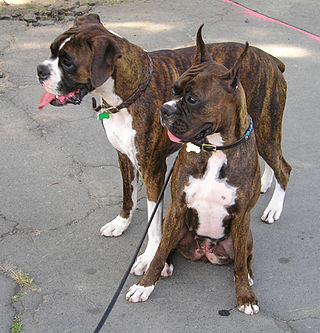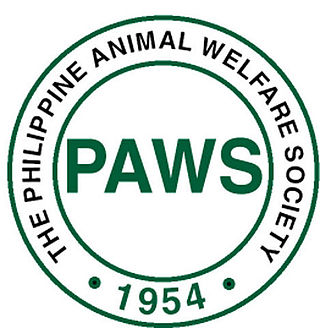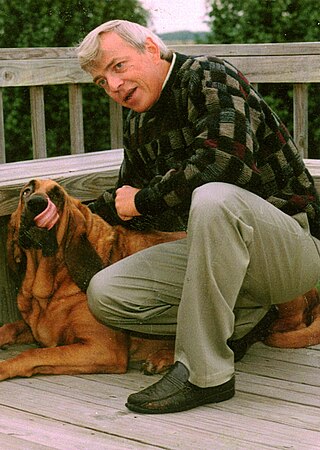
Neuticles are prosthetic testicular implants for neutered dogs and other domestic animals. [1] The implants may be made of polypropylene or silicone. [2]

Neuticles are prosthetic testicular implants for neutered dogs and other domestic animals. [1] The implants may be made of polypropylene or silicone. [2]
Gregg Miller developed the idea for Neuticles after his bloodhound, Buck, was castrated to stop his wandering. [3] Miller, along with a veterinarian, patented the procedure for implanting Neuticles. [4] To sell his idea, Miller established CTI (Canine Testicular Implant) Corporation, [3] and the first commercial Neuticles were implanted in 1995. [1] Miller won the 2005 Ig Nobel Prize in Medicine, a parody of the real Nobel Prize, for the invention of Neuticles. [5] [6]
While recognizing that responsible pet ownership requires neutering, nonetheless, many pet owners find themselves uncomfortable with such a disfiguring procedure. The permanently altered appearance of their pet serves as a constant reminder of their surgical choice. Comments by strangers who misidentify the gender of the pet may serve to exacerbate this discomfort.
— US Patent 5868140A [7]
The company states that humans cannot legally get Neuticles; while the materials in them are approved by the FDA, a second approval is required for similar implants in any specific areas of the human body. [8] In 2018 it was reported that Miller has no plans for Neuticles for humans due to the cost and the time needed for FDA approval. [9]
In the UK, the regulatory body for veterinarians, the Royal College of Veterinary Surgeons, states that the use of any form of cosmetic surgery is unethical. [10]
The Veterinary Council of New Zealand says "the insertion of neuticles (prosthetic testicles) cannot be justified. This procedure has no benefit to the animal and can be used to conceal genetic defects." [11]

Cryptorchidism, also known as undescended testis, is the failure of one or both testes to descend into the scrotum. The word is from Greek κρυπτός 'hidden' and ὄρχις 'testicle'. It is the most common birth defect of the male genital tract. About 3% of full-term and 30% of premature infant boys are born with at least one undescended testis. However, about 80% of cryptorchid testes descend by the first year of life, making the true incidence of cryptorchidism around 1% overall. Cryptorchidism may develop after infancy, sometimes as late as young adulthood, but that is exceptional.
Neutering, from the Latin neuter, is the removal of a non-human animal's reproductive organ, either all of it or a considerably large part. The male-specific term is castration, while spaying is usually reserved for female animals. Colloquially, both terms are often referred to as fixing. In male horses, castrating is referred to as gelding. An animal that has not been neutered is sometimes referred to as entire or intact.

Docking is the removal of portions of an animal's tail. While docking and bobbing are more commonly used to refer to removal of the tail, the term cropping is used in reference to the ears. Tail docking occurs in one of two ways. The first involves constricting the blood supply to the tail with a rubber ligature for a few days until the tail falls off. The second involves the severance of the tail with surgical scissors or a scalpel. The length to which tails are docked varies by breed, and is often specified in the breed standard.

Dog aggression expressed by dogs is considered to be normal behaviour and various types of aggression are influenced by a dog's environment and genetic predisposition. Dogs commonly display possessive aggression when defending resources or themselves.
Devocalization is a surgical procedure where tissue is removed from the vocal cords.

The health of dogs is a well studied area in veterinary medicine.
Organ replacement in animals is an emerging field in veterinary science, focusing on improving and prolonging the lives of animals through the replacement or augmentation of damaged or dysfunctional organs. Despite its relative rarity compared to limb prosthesis, strides have been made over the decades, with notable milestones such as the first pacemaker surgery on a dog in 1968 and successful kidney transplants in cats since the mid-1980s. This field faces challenges, particularly in canine programs, due to issues related to immunosuppression. Ethical considerations also exist, particularly concerning the treatment of donor animals, underscoring the need for ongoing discussions and regulations in this dynamic field.

Veterinary surgery is surgery performed on animals by veterinarians, whereby the procedures fall into three broad categories: orthopaedics, soft tissue surgery, and neurosurgery. Advanced surgical procedures such as joint replacement, fracture repair, stabilization of cranial cruciate ligament deficiency, oncologic (cancer) surgery, herniated disc treatment, complicated gastrointestinal or urogenital procedures, kidney transplant, skin grafts, complicated wound management, and minimally invasive procedures are performed by veterinary surgeons. Most general practice veterinarians perform routine surgeries such as neuters and minor mass excisions; some also perform additional procedures.
Canine reproduction is the process of sexual reproduction in domestic dogs, wolves, coyotes and other canine species.

Vaccination of dogs is the practice of animal vaccination applied to dogs. Programs in this field have contributed both to the health of dogs and to the public health. In countries where routine rabies vaccination of dogs is practiced, for example, rabies in humans is reduced to a very rare event.
North Carolina State University College of Veterinary Medicine is an American educational institution located in Raleigh, North Carolina that offers master's and doctorate-level degree programs; interdisciplinary research in a range of veterinary and comparative medicine topics through centers, institutes, programs and laboratories; and external engagement through public service programs and activities.

The Philippine Animal Welfare Society (PAWS) is a volunteer-based, non-government organization whose goal is to prevent animal cruelty through education, animal sheltering and advocacy, based in Quezon City, Philippines. It was founded in 1954 by Muriel Jay. PAWS believes that the creation of a more peaceful society starts with the widening of mankind's circle of compassion which includes animals, thereby envisions a nation that respects animals, practices responsible pet ownership and protects wildlife. The volunteer-based organization rehabilitates these animals in the hope of finding them new homes and a second chance at a good life. PAWS does not take in pets of other people, but only victims of cruelty or neglect where the animal offenders are charged with violation of the Animal Welfare Act in court.

Canine glaucoma refers to a group of diseases in dogs that affect the optic nerve and involve a loss of retinal ganglion cells in a characteristic pattern. An intraocular pressure greater than 22 mmHg (2.9 kPa) is a significant risk factor for the development of glaucoma. Untreated glaucoma in dogs leads to permanent damage of the optic nerve and resultant visual field loss, which can progress to blindness.
Robert L. Rooks is an American veterinarian. He is the founder of All-Care Animal Referral Center in Fountain Valley, Orange County, California. He is a diplomate of both the American Board of Veterinary Practitioners and the American College of Veterinary Surgeons.

Cropping is the removal of part or all of the external flaps of an animal's ear. The procedure sometimes involves bracing and taping the remainder of the ears to train them to point upright. Almost exclusively performed on dogs, it is an old practice that was once done for perceived health, practical or cosmetic reasons. Veterinary science states there is no medical or physical advantage to the animal from the procedure, leading to concerns of animal cruelty over performing unnecessary surgery on animals. In modern times, cropping is banned in many nations, but is still legal in a limited number of countries. Where permitted, it is seen only in certain breeds of dog, such as pit bull and bull terrier type breeds, the Doberman Pinscher, Schnauzer, Great Dane, Boxer and Cane Corso.
The Abu Dhabi Falcon Hospital (ADFH) is the first public medical institution exclusively for falcons in the United Arab Emirates. Established by Environment Agency – Abu Dhabi and opened on 3 October 1999, Abu Dhabi Falcon Hospital has become the largest falcon hospital in the UAE and in the world with a patient influx of approximately 11,000 falcons per year. The ADFH describes their mission as a goal "To protect, conserve, research, and promote captive-bred and wild falcons health, wildlife, and falconry tradition. To lead efforts of Abu Dhabi government to improve and protect animal welfare and to increase awareness and responsibility of people for animal welfare as the leading center for animal healthcare and welfare in Abu Dhabi Emirate."

Gregg Miller is an American inventor, who trademarked Neuticles, testicular implants for pets.
Zeuterin (zū-tur-in) is the trade name of an injectable product containing zinc gluconate and the amino acid arginine, which is used for sterilizing young male dogs without the removal of the testicles. The product is injected directly into the testicle, where the zinc gluconate destroys the sperm and causes inflammation, which leads to fibrosis and causes sterility. Sperm production continues for up to 60 days after product administration, and in some dogs does not stop completely, although the product is 99.6% effective when given to dogs aged 3-10 months of age. Following administration, the testicles atrophy; the degree of atrophy may vary noticeably between testicles. The male hormone, testosterone, is produced in limited quantities following treatment with Zeuterin, but after two years, testosterone production is similar to that in untreated dogs. The continuing presence of testosterone means that, unlike surgical castration, chemical castration does not remove the risk of testosterone-associated disease, such as prostatic disease.
Canine gallbladder mucocele (GBM) is an emerging biliary disease in dogs described as the excessive and abnormal accumulation of thick, gelatinous mucus in the lumen, which results in an enlarged gallbladder. GBMs have been diagnosed more frequently in comparison to prior to the 2000s when it was considered rare. The mucus is usually pale yellow to dark green in appearance.
Non-surgical fertility control is the prevention of reproduction without the use of surgery. The most common form of sterilization in dogs and cats is surgical, spaying in females and castration in males. Non-surgical fertility control can either result in sterilization or temporary contraception and could offer a cheaper way to keep wild dog and cat populations under control. As of 2019, only contraceptives are commercially available. Research is ongoing into methods that could result in permanent suppression of fertility.